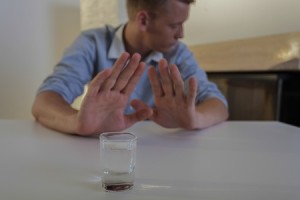The End of Alcoholism? Part 3

“One of the first duties of the physician is to educate the masses not to take medicine.” Sir William Osler, physician
Olivier Ameisen wrote in The End of My Addiction that thoughts about an addictive substance could insinuate themselves into an addict’s consciousness and quickly preoccupy the whole mind with anxiety about how to get it. “This is a harrowing experience mentally and emotionally as well as physically, because it is charges with shame and self-loathing for even experiencing the craving.” Cravings could propel him into a trance-like state. He would set out to buy liquor, feeling as if someone else was controlling his body. “When craving defeated me, I could only hope, pray, and strive to do a better job of resisting it the next day.”
Ameisen was “a French-American male physician with alcohol dependence and comorbid pre-existing anxiety disorder.” He said he had been plagued by anxious feelings of inadequacy throughout his life. He’d been seeing therapists for a long time before he started drinking. They were never much help with his anxiety. “Nor was the Xanax they prescribed me.” So he turned to alcohol.
I was terrified of living without alcohol. Without it, I would be an anxious wreck. Admitting my problem drinking to most of my friends and my colleagues terrified me too. I feared being ostracized, and since I felt that drinking should be under my control I felt ostracism would be justified.
He told every physician and therapist he saw that his fundamental problem was anxiety, “which expressed itself in chronic muscle tension, and which intensifying to a panic state, triggered the overwhelming need to drink for relief.” None of the addiction professionals took him seriously. So he looked around to prescribe his own treatment. He thus disregarded another observation of the Canadian physician, William Osler: “A physician who treats himself has a fool for a patient.”
An old girlfriend sent him a copy of a New York Times article that discussed baclofen reduced craving with cocaine, but he was in the midst of a binge and misplaced the copy. He eventually contacted the doctor mentioned in the article and asked her about baclofen. Although he was encouraged by the conversation, his alcohol treatment specialist and psychiatrist weren’t interested in discussing an unproven medication. In early February of 2002 he began doing an internet research into baclofen. Panic was his most crippling symptom, so he searched first under “baclofen panic.” He found several reported studies, including the 2000 study by Addolorato, “Ability of baclofen in reducing alcohol craving and intake.”
Ameisen developed a theory that there is a “threshold dose” of baclofen needed to break the cycle of craving, preoccupation and obsessive thoughts with alcoholism. And he decided to try out the theory on himself. He began his self-medicated treatment with baclofen on January 9, 2004. See “The End of Alcoholism? Part 1” for a fuller description of this process. Ameisen did attempt social, controlled drinking, about fifteen months after establishing alcohol abstinence by taking baclofen. But he said he preferred not drinking. James Medd in The Guardian suggested that “He can now drink socially—an idea entirely counter to the teachings of AA and most other therapies.”
Ameisen saw anxiety as his primary disorder, with his drinking as a way to self-medicate his anxiety. Additionally, he held on to a belief that he should be able to control his drinking: “I should be able to control my urge to drink. . . . Since I felt that drinking should be under my control, I felt ostracism would be justified.” Even though he reportedly went to hundreds of Alcoholics Anonymous (A.A.) meetings, if he held onto a belief that he should be able to control his drinking, he would not be able to effectively use A.A. to remain abstinent, because he didn’t entirely accept their first Step: “We admitted that we were powerless over alcohol, and that out lives had become unmanageable.”
Other medical professionals were concerned with his use of high dose baclofen. Jonathan Crick, the psychiatrist who is the editor-in-chief of Alcohol and Alcoholism, said he’s been encouraged with his own treatment of 50 patients with baclofen, but won’t use the high doses of Ameisen’s method. He stays under 100 mg a day. “I do actually have some concerns about unwanted effects in large doses. . . . This is a drug which is active in the brain, and there are some concerns about some unwanted effects of higher doses.”
I also wonder if he turned a blind eye to some of the concerns raised about baclofen in the literature. He saw it as essential to his own ability to manage anxiety, cravings, and to refrain from compulsive, out of control drinking.
There have been a series of studies reporting what has been called a “baclofen withdrawal syndrome.” A 1981 article, Complication of Baclofen Withdrawal, reported that three patients taking baclofen on a long-term basis experienced hallucinogens and/or seizures with abrupt reduction of their dose or discontinuation of baclofen therapy. A 1998 article, “Prolonged Severe Withdrawal Symptoms,” reported that an abrupt decrease or too rapid taper off baclofen could result in a withdrawal syndrome manifesting hallucinations, delirium, seizures and high fever.
A 2005 study, “Delirium Associated with Baclofen Withdrawal,” reviewed 23 published cases of psychiatric symptoms with baclofen withdrawal. Delirium, but not other symptoms was found to arise from abrupt baclofen withdrawal. The delirium appeared to be greater in individuals who received chronic baclofen therapy. A 2001 case study reported on the case of a man with neuroleptic malignant-like syndrome, with disorientation, signs of autonomic dysfunction and rigidity from abruptly stopping his long-term baclofen treatment. “He improved markedly after the reintroduction of baclofen.”
In contrast to published studies saying that baclofen helped with alcohol withdrawal, a Cochrane review published in May of 2015, “Baclofen for alcohol withdrawal syndrome,” concluded that the evidence for recommending baclofen for alcohol withdrawal syndrome was insufficient. “We therefore need more well-designed RCTs to prove its efficacy and safety.”
A 2013 article assessed the potential to confuse baclofen withdrawal for alcohol withdrawal. The authors said the clinical and psychopharmacological overlap between acute intoxication and the withdrawal symptoms of baclofen, alcohol and benzodiazepines could lead to diagnostic uncertainty. “In every case of unexplained confusion, agitation, hallucinations, seizures, and psychosis occurring in patients with current drinking, both AWS and BWS should be systematically considered.”
A small study by Franchitto et al. in 2013 did a retrospective study of the medical records for 12 individuals diagnosed with alcohol dependence who had overdosed on baclofen. The median dose of ingested baclofen was estimated at 340 mg. Ten had a previous suicide attempt. Three had co-ingested benzodiazepines. The “classic” effects of baclofen overdose associated with neurotransmitter inhibitory effects were evident:
Impaired consciousness or coma, generalized muscular hypotonia with absent limb reflexes, respiratory depression, seizures, hemodynamic changes and cardiac abnormalities such as supraventricular tachycardias, premature atrial contractions and first-degree heart block.
Four patients were in coma before admission, and required intubation and respiratory support. Coma after a baclofen overdose may persist for several days because of the drugs’ depression of neuronal activity in the central nervous system. Nevertheless, the authors concluded that consistent with other reports, “most patients with baclofen overdose had a good outcome with adequate supportive care.”
There have been reports of heart problems and even mania. A 2014 case report concluded that cardiac arrest occurred with baclofen withdrawal syndrome. A 2014 article concluded that baclofen-induced manic symptoms could appear in individuals regardless of a history of bipolar or mood disorders. The question to be raised about the use of baclofen for alcohol use disorders is what effects does it have on the brain? To the extent that these effects correspond to the effects of alcohol, or any other potentially “addictive” substance, its use in substance misuse treatment is a double-edged sword.
A 2015 study by Rigal et al. reviewed the records of 146 patients who used baclofen to treat their alcohol use disorder. Ninety (78%) reported at least one adverse effect. The most frequently reported adverse effect was a disruption of the wake-sleep cycle in 73 patients (63%). “Persistent adverse effects occurred in 62 patients (53%).” There were 8 patients who had adverse effects that led them to stop taking baclofen. Women reported more adverse events than men. “High-dose baclofen exposes patients with alcohol disorders to many adverse effects. Generally persistent, some adverse effects appear at low doses and may be dangerous.”
The evidence seems clear for a baclofen withdrawal syndrome. There is a state of tolerance or dependence that develops with long term, high dose use. Are patients given baclofen informed of the potential for them to develop a dependency upon this medication? My concern is this dependency is a “sleeper” symptom that initially goes largely unnoticed as with medications used to “treat” opioid use disorders—buprenorphine, and methadone. This same problem with dependency also exists with benzodiazepines prescribed for anxiety or sleep disturbance. They initially work so effectively that the dependency, if it’s noticed at all, is minimized. Only after it becomes seriously entrenched physically and psychologically do people realize what has happened.
So where might all of this lead? Baclofen is a generic drug with no potential for a pharmaceutical company to patent, and thus become a highly profitable product for them. So pharmaceutical companies are largely not interested in developing baclofen as a treatment for addictions. However, there is a prodrug version of baclofen called arbaclofen palcarbil that was initially in development by XenoPort as a treatment for GERD and spasticity due to multiple sclerosis. In May of 2013, XenoPort announced that Phase 3 clinical trials for arbaclofen palcarbil were unsuccessful and they decided to terminate further investment in the program.
In May of 2014, Reckitt Benckiser Pharmaceuticals and XenoPort announced they had entered into a joint license agreement, where Reckitt Benckiser will have the exclusive rights to develop and commercialize arbaclofen palcarbil as a treatment for alcohol use disorder.ClinicalTrials.gov indicated that a Phase 2 study by Reckitt Benckiser was scheduled to begin in September of 2015 and should be completed by April of 2016. The purpose of this clinical trial is to determine the maximum tolerated dose of arbaclofen palcarbil in treating alcohol use disorder.
Reckitt Benckiser appears to be looking for a replacement blockbuster product since its opioid treatment drug, Suboxone, went generic. Before losing its patent rights, Suboxone had become a billion dollar drug for Reckitt Benckiser, rising to the 25th best selling drug of 2010, according to drugs.com. The existing research on baclofen gives us a pretty good idea on what the future holds for any arbaclofen palcarbil product. Also, the potential population for a maintenance drug for alcohol use disorder is significantly larger than there was for an opioid maintenance drug. If Reckitt Benckiser can successfully move arbaclofen palcarbil through the FDA approval gauntlet, we will see a patented knock off product of baclofen on the market to treat alcohol use disorder in a few years.
Suboxone made another top drug list in 2013. It was listed as the #2 most abused prescription drug of 2013 by Genetic Engineering & Biotechnology News. Hopefully, any arbaclofen palcarbil product will not repeat that ‘achievement’ for Reckitt Benckiser.


